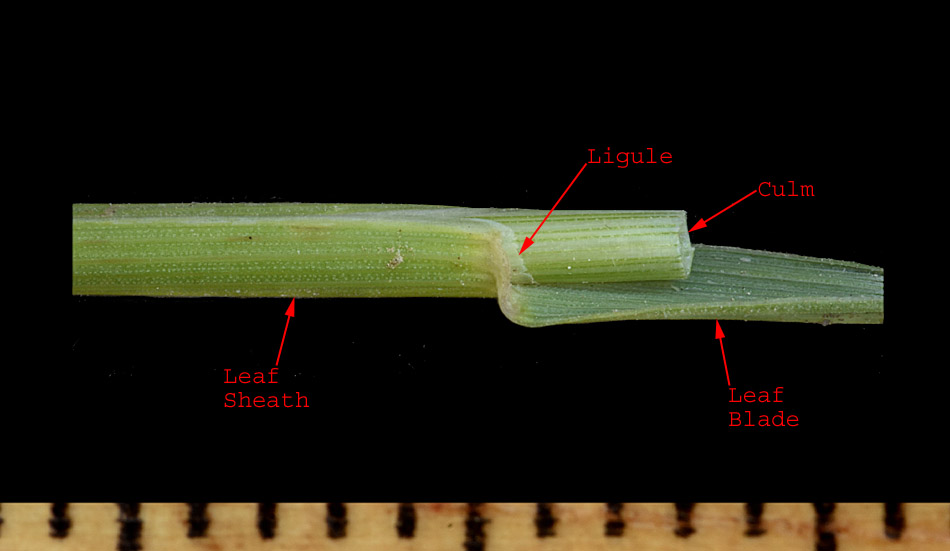 | Triticeae: Answers to key questions
leading to this tribe.
 | Mature inflorescence, if breaking into units, then the units not as
below; NOT [Mature inflorescence breaking into spikelet units consisting
of a sessile fertile spikelet, a hairy pedicel with or without a sterile
spikelet at tip, and a hairy rachis joint, all arising at the same point
(a node) in specialized panicle branches called rames] |
 | Spikelets not as below; sterile florets if present, either located
distal to the fertile floret(s) on the rachilla or paired and attached
at the base of a single fertile floret, not paired with the upper glume
as below; lemma and palea variously textured, enclosing the flower or
not; disarticulation usually above the glumes; NOT [Spikelets usually
dorsally compressed, appearing 1-flowered but containing 1 fertile
floret and 1 sterile floret, the latter attached to the base of fertile
floret opposite the upper glume, resembling the upper glume, and
together with the upper glume enveloping the fertile floret; lower
glumes minute (sometimes absent) to 3/4 as long as upper glumes and
typically wrapping most of the way around the pedicel at base; fertile
floret seed-like with chartaceous-indurate lemma and palea enclosing
flower and fruit; disarticulation below the glumes with rare exceptions] |
 | Spikelets 1 to many-flowered, subtended by a pair of glumes (only 1 on
lateral spikelets in Lolium); palea margins enclosed or not; plants of
dry or wet habitats; NOT [Spikelets 1-flowered, lacking glumes; margins
of the palea tightly enclosed by the lemma margins on female or perfect
florets; plants of wetlands, often emergent aquatic] |
 | Inflorescence a terminal spike with sessile
or subsessile spikelets attached broadside at nodes on opposite sides of
the rachis; NOT [Inflorescence not as above; if a terminal spike, then the lateral
spikelets attached edgewise to the rachis with inner (upper) glume
wanting (as in Lolium)]
|
|
 | Hordeum: Answers to key questions
leading to this genus.
 | Spikelets 2 or more per node, occasionally 1 at some nodes; NOT
[Spikelets 1 per node, occasionally 2 at some nodes] |
 | Spikelets 3 per node with 1 floret per spikelet; florets in central
spikelet always fertile, those in the 2 lateral spikelets sterile and
greatly reduced in plants that disarticulate at rachis nodes but may be
fertile in plants with a continuous rachis; NOT [Spikelets 2-7 per node
with 1-7 (9) florets per spikelet; if spikelets 3 per node, then some
spikelets with more than 1 floret]
|
 | Jubatum: Answers to key questions
leading to this species.
 | Lateral spikelets pedicellate and sterile; auricles absent; spikes
disarticulating at rachis nodes at maturity; NOT [Usually one or both
lateral spikelets sessile and fertile; auricles to 6 mm long,
well-developed; spikes usually not disarticulating at maturity] |
 | Glumes 15-85 mm long, moderately to strongly divergent; awns of lemma
in central spikelet 11-90 mm long; NOT [Glumes 7-19 mm long, ascending
to slightly divergent; awns of lemma in central spikelet 3.5-14 mm long] |
|
|

